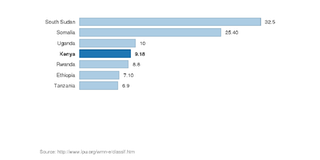Does Kenya have too many MPs?

South Sudan and Somalia have far more legislators per one million people than the rest of Eastern Africa. GRAPHIC | NATION SOURCE: INTER-PARLIAMENTARY UNION
What you need to know:
- Rwanda, like Kenya has nine legislators per million people. Tanzania and Ethiopia have eight, while Uganda has ten.
- The six countries sampled, namely, the United Kingdom, Italy, Spain, Germany Russia and France, all have highly productive economies, with GDP per capita ranging from 10 times that of Kenya (Russia) to 63 times that of Kenya (United Kingdom).
- The leading economies of Asia and South America are lightly represented, yet have highly efficient economies.
Kenya does not seem to have too many national legislators for its people, a Nation Newsplex investigation has found. However, a less productive economy means political representation has a bigger impact on national wealth in Kenya than it does in other countries.
Out of 36 countries around the world surveyed for their Parliamentary representation, only Ethiopia, Samoa, Fiji and the Solomon Islands in Oceania had more representatives than Kenya per dollar of gross domestic product (GDP).
To determine how heavily represented countries were, the number of national parliament seats in each country were divided by national populations to determine how many legislators serve a million people in every country. The number of legislators per million was then factored against GDP per capita, to determine the impact of supporting legislators on each citizen’s wealth.
Kenya pays its legislators a far higher portion of GDP per capita in salary than these wealthy countries do.
Data was parliamentary seats was obtained from the Inter-Parliamentary Union.
The investigation, completed in cooperation with the Institute of Economic Affairs, shows political representation does not appear to place an inordinate burden on Kenyans when the country’s representation is compared to its neighbours.
Kenya has 418 members of parliament, including ex-officio and nominated members, which amounts to about nine legislators for every one million people. Rwanda, like Kenya has nine legislators per million people. Tanzania and Ethiopia have eight, while Uganda has ten.
By far the highest rates of representation are found in South Sudan and Somalia, which have faced protracted conflicts, with 25 and 32 legislators per million people, respectively.
Outside East Africa, this trends changes, starting with the rest of Africa. Comparing Kenya with ten other leading African economies shows that while Kenya rate’s of representation is not uncommonly high, democracy is less costly to citizens of other countries, even those that are more heavily represented.
Of the ten African countries selected, all those which have more legislators per million people than Kenya does also have a higher GDP per capita than Kenya does.
Morocco and Tunisia, which both have almost twice as many legislators per million people as Kenya, and Algeria with more than 50 per cent more legislators, have GDP per capita ranging from nearly four times to more than five times that of Kenya. Only Ethiopia has both fewer legislators per million people as well as a smaller GDP per capita.
In Europe, the trend is replicated more starkly. The six countries sampled, namely, the United Kingdom, Italy, Spain, Germany Russia and France, all have highly productive economies, with GDP per capita ranging from 10 times that of Kenya (Russia) to 63 times that of Kenya (United Kingdom).
Worth noting is that Kenya pays its legislators, a far higher portion of GDP per capita in salary than these wealthy countries do.
Compared to Europe, Kenya does not seem to have too many legislators. For every million people, the United Kingdom has 22 legislators, Spain has 13, while Italy has 10, compared to Kenya’s nine.
Canada, with 10 legislators per million people, and Australia with nine legislators per million people, have similar Westminster-style parliaments to the United Kingdom, and a similar number of legislators per million people to Kenya. However, given their GDP per capita is far in excess of Kenya’s there is no evidence that the representation has hindered their prosperity.
While Germany has a rate of representation close to Kenya at eight legislators per one million people, France and Russia are much more lightly represented, with two and four legislators per one million people respectively.
Compared to Kenya, countries in South America have relatively few legislators per million people, with Chile having eight, Argentina seven, Colombia and Venezuela five, Peru four and Brazil two.
The same is true of Asia, where South Korea and Saudi Arabia have five legislators, Iran has three, and Indonesia and China both have two. Japan and India do not have one representative for every million people, with rates of 0.4 and 0.6 respectively. Kenya has more national representation per million population than North American countries.
The leading economies of Asia and South America are lightly represented, yet have highly efficient economies.




